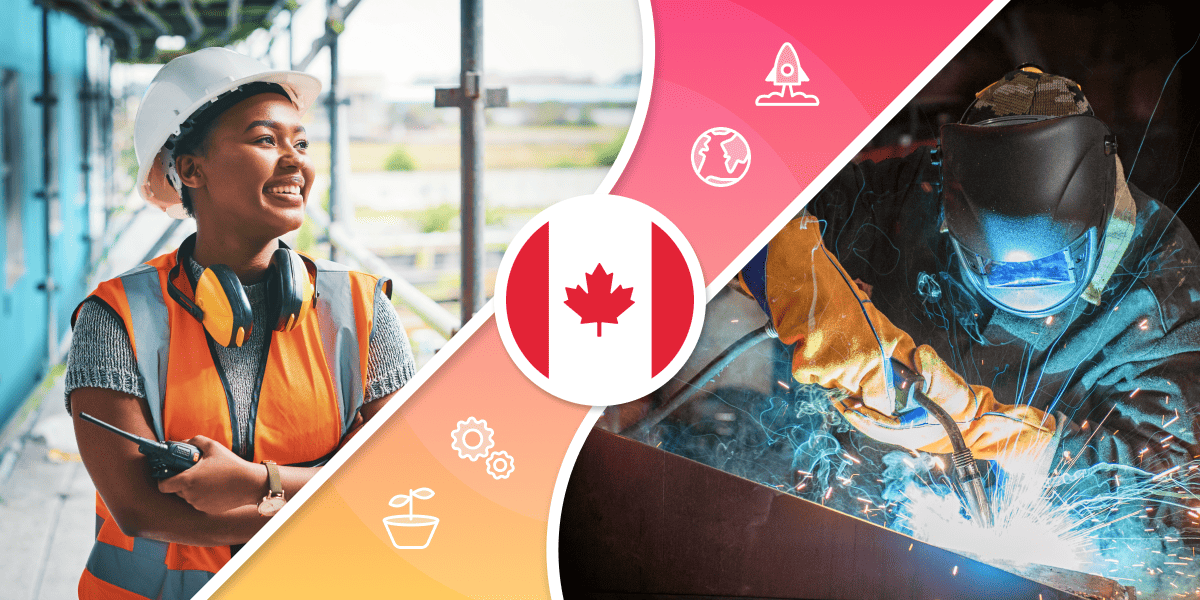Did you know that between 2002 and 2028, it’s estimated that around 700,000 skilled tradespeople are expected to retire in Canada? This workforce turnover means that training and recruiting new tradespeople is deeply important to Canada’s economy. Read on to learn more about Canada’s skilled trade sector, and some in-demand Canadian skilled trades programs for international students.
Skilled tradespeople help homes, businesses, and cities grow and run effectively. Whether you choose to work in hospitality, goldsmithing, crane operation, or collision repair, every trade requires hands-on work and attention to detail. For international students, studying the skilled trades means developing a focused skill set while earning practical experience and industry connections through apprenticeships and co-op terms.
What Are the Skilled Trades?
In Canada, skilled trades—sometimes called vocations—are jobs where you work with your hands and require specialized training. Think you know all the trades out there? It’s likely some will surprise you—in Canada, there are over 300 designated trades. Of that number, 54 are Red Seal certified. This means that once you’ve passed the Red Seal exam, your certification will be recognized everywhere in Canada and you won’t have to recertify if you move.
Per the Government of Canada, most skilled trades fit under one (or more) of the following five sub-sectors:
Construction
Passionate about building? This in-demand field includes trades like electricians, plumbers, carpenters, heavy equipment operators, and welders.
Information and Digital Technology
Digital skills are a growing part of many trades, which include crane operators, machinists, and network technicians.
Manufacturing and Industrial
This field brings together automotive manufacturing, product manufacturing, resource extraction, and processing trades. Careers include process operation, industrial mechanics, vehicle machining, and cabinet making.
Services
A massive part of the Canadian economy, service trades include everything from landscape horticulturist to cook, hairstylist, or youth worker.
Transportation
Focusing on vehicle repair and maintenance, transportation tradespeople include motorcycle technicians, automotive service technicians, and heavy-duty mechanics.
Once you’ve been accepted into a study program and have your student visa, what’s next? Use our Pre-Arrival Checklist for International Students as a guide.

Which Trades Are in High Demand in Canada?
The skilled trades with the highest projected demand between 2022 and 2026 are:
- Cook
- Industrial electrician
- Industrial mechanic (or millwright)
- Painter and decorator
- Welder
That said, all trades grads will enter a job market that’s growing quickly. If you want to live in a specific part of Canada, check out the federal chart listing top trades jobs by region, too.
In fact, as many trades programs integrate more tech-based skills, new grads may help to modernize their workplaces. For example, your knowledge of new tech might mean introducing tools like drones, advanced sensors, and autonomous vehicles to your workplace.
If you’re a student interested in becoming a Canadian permanent resident through the Express Entry Federal Skilled Trades Program (FSTP), you’ll need to earn work experience after graduating (work you do during your studies doesn’t count towards FSTP). Generally, you’ll need either two years of full-time work or equivalent part-time work in the same trade over the five years prior to applying.
While FSTP doesn’t have an education prerequisite, applicants get points for graduating from relevant programs in Canada. By studying in Canada, and apprenticing with local companies, students build relationships that may lead to a job offer—another FSTP requirement.
Before you can work in a trade, you’ll need to apply for your study program and student visa! Here are our top dos and don’ts to know when applying for your Canadian student visa.

Featured Canadian Skilled Trades Programs
In skilled trades programs, you’ll learn current trade practices. Plus, hands-on class time means lots of experience with tools you’ll use on the job. You’ll also learn how to stay safe, whether you’re working with table saws, bulldozers, or hair dyes. Let’s look at some Canadian skilled trades programs that are popular with international students. Our list aligns with the top trades above, but remember—each of these institutions offer many more programs. If you can dream it, it’s likely you can study it.
Welding Technician
Welding technicians know how to cut, fit, and weld industrial materials together using heat and pressure to build everything from planes and bicycles to air seals and medical devices. In class, you’ll also learn about manufacturing codes and standards, so you can apply your expertise safely in construction and industrial projects. During this two-year Welding Technician diploma program at Niagara College, students take their metal fabrication projects from engineering drawings through the forming and welding processes.
You’ll study at Niagara College’s Welland, Ontario campus, which houses a full-size weld shop and fabrication lab, plus an accredited Canadian Welding Bureau test centre. The city of Welland is located in some of Canada’s best farmland and vineyards, and is close to Niagara Falls. To enjoy big-city life, Toronto is a reasonable road-trip away on weekends, and is also accessible by train.

Culinary Arts
Southern Alberta Institute of Technology (SAIT) is respected internationally for their two-year college diploma in Culinary Arts. In 2024, CEOWorld Magazine called SAIT one of the World’s Best Hospitality and Hotel Management Schools, ranking #14th globally.
SAIT is located in the city of Calgary, Alberta, which tied with Geneva, Switzerland for the fifth-most livable city in the world in the Economist’s 2024 rankings. It scored particularly well for its stability, health care, and education—and locals love its vibrant cultural scene and proximity to the Rocky Mountains.
The Culinary Arts program includes an internship, and time working in classroom restaurant environments like the Highwood restaurant or The Butchery, an on-campus meat market which is the first of its kind in Canada. Students learn everything from patisserie to culinary diplomacy, developing foundational cooking skills and knowledge of industry trends.

Construction/Industrial Electrician
Learn how to keep buildings safe as a Construction/Industrial Electrician. You’ll learn how to install, alter, and maintain electric systems that provide heat, power, and more to buildings. From testing circuits to reading architectural drawings, you’ll pick up key skills in class and at a work placement.
This 37-week post-secondary certificate is offered by Newfoundland and Labrador’s College of the North Atlantic at their Labrador West, Happy Valley-Goose Bay, and Burin campuses. Completing this certificate will also prepare you to write the Red Seal exam for this trade.
Manufacturing Engineering Technician – Automation (Industrial Mechanic Millwright)
Prepare for your future! This program enables grads who become registered apprentices to skip the in-school training part of the Industrial Mechanic (Millwright) apprenticeship. Plus, the Manufacturing Engineering Technician program has an optional co-op term where students gain apprenticeship hours while still learning.
This two-year undergraduate diploma at Mohawk College’s Stoney Creek Campus for Skilled Trades immerses students in a hands-on environment. There you’ll troubleshoot automated systems, learn AutoCAD and PLC programming, and practice machine fabrication. With a campus 20 minutes from downtown Hamilton, Ontario, students also enjoy a more affordable cost of living while being close to a larger city.
Interior Decorating
International students will gain vital strategic, software, and industry knowledge related to interior design through this two year diploma. The Interior Decorating diploma program at Bow Valley College is taught by industry experts, and is recognized by the Decorators & Designers Association of Canada.
Bow Valley College has an impressive graduate approval rate of 94%, and is located in Calgary, Alberta’s lively downtown. Nearby transit and bike routes also make getting to class easier. Because BVC encourages wellbeing in and out of the classroom, all students also have access to learner support services and academic services.

Canada’s skilled trades sector is growing and diverse. This means there’s a space for everyone to build their knowledge in this vital sector. No matter which trade you choose, best of luck with your study abroad journey!
Ready to find the skilled trades program that matches your goals? Check out the ApplyBoard platform. With over 140,000 current study abroad programs, you’re bound to find a great fit.






wigt60
Usually I do not read article on blogs however I would like to say that this writeup very compelled me to take a look at and do so Your writing taste has been amazed me Thanks quite nice post
Noodlemagazine I appreciate you sharing this blog post. Thanks Again. Cool.
civhvl